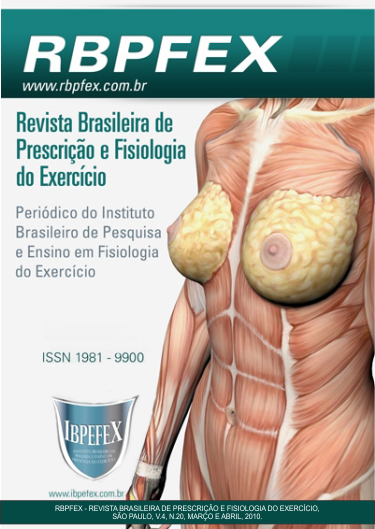The Social, health and anthropometric profile of newcomers in a Porto Alegre’s gym
Abstract
Objective: The objective of this project is verify the social, health and anthropometric profile of a newcomer of both genres between age-group of 18 and 80 years old in a Porto Alegre’s gym. Materials and methods: The instrument of information data is a document containing a list of questions to be answered to detect the social and health profile. To detect the IMC a Filizola weighing machine was used. To detect the RCQ a tape measure was utilized and for % Fat, Pollock and Jackson was used. Results: Social profile 47%F and 53%M, age-group between 18 and 29 years old 60%F and 66%M. Professional type between complete and incomplete superior level. 51%F and 62%M. About the Civil Status 64%F and 69%M are single or divorced.71%F and 82%M work. In relation to BMI 56%F and 45%M are healthy, RWH 31,5%F are moderate and elevated and 31%M low, %Fat 31,5% between 22,1% and 28% and 34%M between 16% and 22%, health profile, 64%F and 60% objectives the good health, 84%F are non physical activity praticating and 51%M praticates 82%F and 86%M were physical activities praticators. 93%F and 73%M shown some disease in family, 53%F shown some disease and 69%M not. 96%F and 80%M have no restriction about the exercises,80%F and 90%M didn’t pass through a surgery, 60%F and 80%M didn’t show allergy or are a medicament user. 56%F and 78%M has no lesion, 78% and 98%M are not on diet with medical accompaniment. Conclusion: As soon as the physical educator identify the social and anthropometric profile he can offer activities that answer more correctly the requirements and objectives of new comers in a gym.
References
- Amer, N.M; Sanches, D.; Franzoi De Moraes, S.M. Índice de massa corporal e razão cintura/quadril de praticantes de atividade aeróbica moderada. Revista Da Educaçâo Física/UEM. Vol. 12. Num. 2. 2001. p. 97-103.
- Azambuja, C.R.; dos Santos, D.L. Consumo de Recursos Ergogênicos e Farmacológicos por Praticantes de Musculação das Academias de Santa Maria/RS. Revista Brasileira de Fisiologia do Exercício. Vol. 5. Num. 1. jan/dez 2006. p. 27-33.
- Barbosa, A.M.; Alves, F.B.; Pires-Neto, C.S. Indicadores de sobrepeso e obesidade em participantes de musculação na faixa etária entre 20 e 34 anos. In: XXV Simpósio Internacional de Ciências do Esporte, 2002, São Paulo. Revista de Ciência e Movimento. Vol. 10. Num. 4. suppl, 2002. p. 224.
- Bramante, A.C. Programa de Atividades Físicas em grupos especiais. In: 1º Congresso brasileiro de atividade física & saúde. 1997, Florianópolis. Anais do Congresso. Florianópolis: 1997, p.15.
- Consenso Latino Americano de Obesidade. Documento oficial. 1998: Rio de Janeiro. www.abeso.org.br,2001. Acessado on line: 27/07/2009.
- Dos Santos, K.G.L.; Da Silva, M.A.G. A Prevalência de Lombalgia em Mulheres Praticantes de Ginástica em Academia Esportiva. Fisioterapia Brasil. Vol. 4. Num. 2. mar/abr 2003.
- Guimarães, F.J.S.P.; Pires Neto, C.S.; Características antropométricas e da composição corporal e suas relações degenerativas (1998). Disponível em: http://www.upe.br/corporis2/artigo3html. Acesso em 27/07/2009.
- Fermino, R.C.; Pinto, G.C. Prevalência de obesidade em praticantes de atividade física. In: 1º Congresso Científico do 6º Meeting. 2002. Florianópolis. Anais do Congresso. Florianópolis: 2002, p.24.
- Fleck, Sj.; Kraemer, W.J.; Fundamentos do Treinamento de Força Muscular. 2ed., Porto Alegre: editora Artes Médicas, 1999.
- Gracia, M.P.; Mello, J.F.; Fernandes, M.F.M.; Wandalsen, N.F. Freqüência de Sintomas Associados à Asma e Doenças Alérgicas em Adultos Jovens, na Cidade de Santo André, SP. Rev Bras Crescimento Desenvol Hum. Vol. 18. Num. 2. 2008. p. 201-208.
- Kruchelski, S.; Rauchbach, R. Programa Curibativa – perfil de saúde e aptidão física da população curitibana. Revista Ação e movimento. Vol. 3. Num. 1. 2004. p. 167-174.
- Liberali, R. Metodologia Científica Prática: um saber-fazer competente da saúde à educação. Florianópolis: (s.n.), 2008.
- Filho, J. Análise da composição corporal: uma revisão de métodos. Revista Brasileira de Cineantropometria & Desempenho Humano. Vol. 4. Num. 1. 2002. p. 80-92.
- Nahas, M.V. Obesidade, controle de peso e atividade física. Londrina: Midiograf. 1999.
- Petroski, E. L. Antropometria. Técnicas e padronizações. Porto Alegre: Pallotti, 1999.
- Saba, F. Aderência: à Prática do Exercício Físico em Academias. São Paulo: Ed. Manole, 2001.
- Silva, G.V.; Müller, T.S. A Busca pela Qualidade de Vida dos Praticantes de Musculação da Academia do Cefid/Udesc. In: Anais do 3º Congresso Brasileiro de Atividade Física e Saúde. Pg.116. Florianópolis: 2001.
- Tahara, A.K.; Silva, K.A. A prática de exercícios físicos na promoção de um estilo de vida ativo. Revista digital Efdeports. Buenos Aires. Ano. 9. Num. 61. Jun., 2003.
- Tribess, S.; Devens, B.R. Perfil antropométrico de ingressantes em um programa de treinamento resistido. In: 16º Congresso Brasileiro de Medicina do Esporte, 2003, Florianópolis. Revista Brasileira de Medicina do Esporte. Vol. 9. suppl.1, jun, 2003.
Authors who publish in this journal agree to the following terms:
- Authors retain the copyright and grant the journal the right of first publication, with work simultaneously licensed under the Creative Commons Attribution License BY-NC which allows the sharing of the work with acknowledgment of the authorship of the work and initial publication in this journal.
- Authors are authorized to enter into additional contracts separately for non-exclusive distribution of the version of the work published in this journal (eg, publishing in institutional repository or book chapter), with acknowledgment of authorship and initial publication in this journal.
- Authors are allowed and encouraged to post and distribute their work online (eg, in institutional repositories or on their personal page) at any point before or during the editorial process, as this can bring about productive change as well as increase impact and impact. citation of published work (See The Effect of Free Access).






